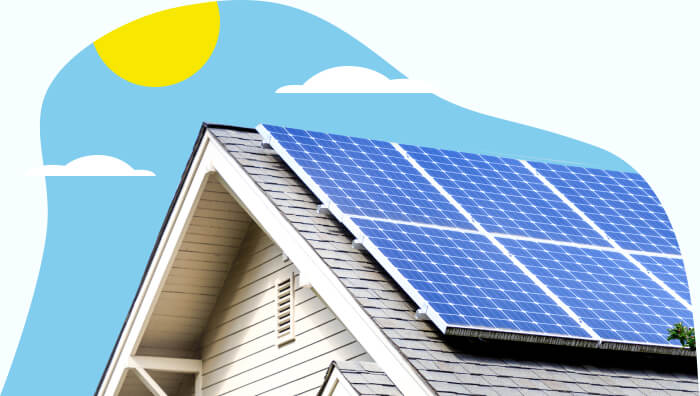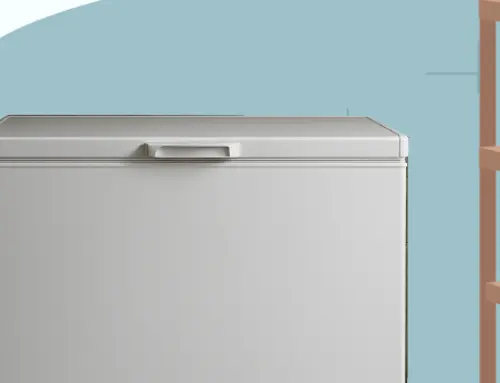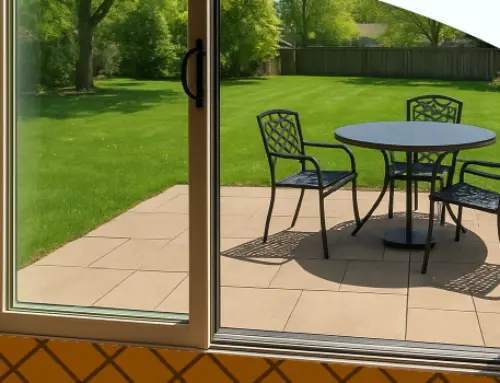Pros & Cons of Using Solar Power (vs. Standard Electricity)
by Tyler Castle
11.7 min read

If you’re looking for more sustainable ways to provide your home with energy, then both earth-friendly utility electrical power and solar energy panels are great options. But, is having your own solar energy panels better than electricity provided by a utility company?
Both energy sources have their pros and cons, but selecting what’s “best” for your home and family will depend on a few key factors, including your energy requirements, financial goals, and even location. Read on for what you need to know when comparing solar panels vs. electricity.
What determines the cost of electricity?
The amount of energy used by all electrical devices in your home is measured in kilowatt-hours (kWh). How much you’ll have to pay for your electricity is determined by the amount of kilowatt-hours you use every month and the amount your electricity provider will charge per kWh.
Who you have as a provider depends on if your home state is a regulated or deregulated energy market. In a regulated energy market, everyone has the same provider, as it’s the government that sets the pricing through a public utility company that is in charge of providing all the electrical power for all consumers. In a deregulated energy market, consumers have a choice of different retail energy providers (REPs). It is the REPs who purchase electricity wholesale from different power plants, set the price and then sell to consumers.
Under both markets, the cost of electricity is determined by the key factors of:
- Fuel price — The price of fuel can increase when demand rises, such as during summer months when more households are using electricity for air conditioning. Disruptions in supply can also cause an increase in price.
- Power plant costs — The prices set by power plants is partially determined by their own costs, including new construction, maintenance, and operating costs.
- Transmission systems — Electricity transmission infrastructure also has operating, maintenance, and construction costs, which can increase after accidents or extreme weather events that require repairs.
- Weather conditions — Extreme weather conditions can increase the demand for electricity to power heating and cooling. Weather conditions can also affect the price of “green” energy, such as a drought putting more strain on hydroelectric power or a season of high winds providing a steady supply of wind energy.
While regulated markets will offer the same cost per kWh for all consumers, different retail energy providers in deregulated markets can provide a range of services and available pricing plans — including fixed pricing, indexed pricing, and hybrid plans.
How do home solar panels generate electricity?
Home solar energy production is different from how retail providers capture solar energy. Power plants use concentrating solar power (CSP) technology, utilizing mirrors to concentrate sunlight into receivers that convert it into heat, which is then used to generate electricity.
Home solar panels use photovoltaic (PV) technology, where sunlight that hits a solar panel is converted into direct current (DC) electricity by a photovoltaic cell. An inverter then converts that electrical charge to alternating current (AC) electricity, which is then distributed throughout your home. Excess energy is either lost, stored in solar batteries for later use, or — if your utility provider supports the process of net metering — is pushed out to your local energy grid to power other local systems.
What determines the cost of home solar energy?
Green or earth-friendly solar plans offered by your utility provider will still cost you per kWH use because the provider has to cover its costs. This can include the cost of equipment, maintenance, distribution systems, replacement parts, storage and purchasing other sources of energy when demand exceeds supply.
Your energy costs when using solar energy will depend on several factors:
- How much power your solar energy system produces
- The amount of electricity your house consumes
- Whether you lease your solar power system or own it outright
- The rates set by your utility to cover the electricity you pull from the grid
- How you’re compensated for the excess solar energy you send back to the grid
To that last point, if your local utility provider supports net metering, then you’ll receive credit for the excess energy they put back out into the grid. Those credits can be used to purchase electricity from the grid during times when your solar panels aren’t generating enough electricity to power everything within the house.
A solar energy system for your home can reduce your reliance on the grid and lower your overall electricity bill, though it’s unlikely to totally eliminate it. You’ll also have to factor in the costs to purchase or lease the equipment, as well as any repairs or maintenance costs over the course of a year.
How much does it cost to install solar panels?
The price of purchasing and installing solar panels will vary based on your location, the system brand, and size of your house. Find Energy estimates the average solar power system to cost around $22,490 before tax incentives, while the Solar Energy Industries Associations (SEIA) estimates a cost of around $25,000 for an average-sized residential home installation.
However, factors such as inflation and supply chain challenges have recently led to instability in the pricing of solar panels and increased costs. Tax incentives provided by state or federal governments can help lower the overall expense.
Solar panels will need to be replaced over time as they lose their efficiency, with the average solar panel lifespan between 25 and 30 years and inverters lasting between 10 and 15 years. You may also need to occasionally hire a technician to repair problems such as corrosion, faulty wiring, or other damage from the environment.
Do you really save money with solar panels?
The amount of money you’ll save with solar panel electricity depends on the amount of sunshine your area receives, your local utility rates, and your net metering program. For example, Marketwatch estimates that a 5kW solar array can save you over $1,000 a year if your provider charges 15 cents per kWh. One of the reasons people believe solar power is better than electricity is that solar energy reduces the amount of energy you need to purchase from the grid, reducing your overall energy costs. Though one of the biggest barriers to installing solar panels is the initial cost, you can either buy the system outright with cash or finance over a period of time — which can increase the overall cost.
Your actual savings will come down to how much sunshine your system gets, how much energy it can produce, how much energy you use, and how much energy you still need to pull from your local grid. On average, a homeowner can expect about eight years for the savings from their solar system to pay for the cost of purchase and installation.
How do I calculate my electricity savings with solar panels?
You can calculate your electricity cost savings using solar panels by multiplying the annual kWh production of your solar system by the kWh billing rate charged by your utility.
Savings per Year = Annual kWh Solar Energy Production × Electricity Rate
Your solar installer will provide the information about the capacity of your solar panel system. As for electricity rates, your actual rates will depend on your location, provider, and season. For this example, we’ll use the standard electricity rate of 16.21 cents per kilowatt hour for the U.S. as of October 2023.
Most solar panels generate approximately 1.5 kWh of electricity per day. Assuming a system is composed of 20 solar panels, it would generate 900 kWh of electricity per month. That number multiplied by a utility billing rate of $0.16.21 per kWh = $146 in monthly savings.
The monthly savings can then be multiplied by 12 to determine your annual savings; in this example $162 x 12 = $1,752 in annual savings.
If we then multiply those annual savings by the average lifespan of a solar panel we can also find lifetime savings. In this example, we’ll multiply $1,752 x 25 years = $44,800 (assuming that electricity rates don’t change over that period). That would cover the average installation cost of $25,000 and provide a total of $18,800 in energy savings over 25 years.
Cost difference of using 20 solar panels for over 25 years
| Average Monthly Electrical Bill* | 25 Year Cost Using Fixed Rate Retail Provider † | 25 Year Cost with 20 Solar Panel System (minus installation costs) | |
| Indiana
(15.17 cents per kWh) |
$136 | $40,800 | $22,000 |
| Illinois
(15.83 cents per kWh) |
$142 | $42,600 | $23,800 |
| Ohio
(16.01 cents per kWh) |
$144 | $43,200 | $24,400 |
| Pennsylvania
(18.43 cents per kWh) |
$166 | $49,800 | $31,000 |
| Michigan
(19.06 cents per kWh) |
$171 | $51,300 | $32,500 |
*Based on the 2022 EIA estimate for monthly usage for an average U.S. residential customer of 899 kWH per month.
† This cost is based on the latest projection from the EIA’s 2023 average and is used for comparative purposes only. Price assumes a fixed rate plan and no changes to rates over 25 years. Santanna prices may vary. Check Santanna’s website for exact rates
Should you get a battery to store excess solar energy?
A solar battery allows you to save excess solar energy for use later. Installing a solar energy storage battery can ensure you’re able to use the power you generate when it’s needed most — such as at night or over long stretches of winter. While a solar battery will reduce the amount of energy you need to pull from the grid, they do carry an additional cost of $6,000-$23,000, not including installation.
Ultimately, the decision if the additional cost savings will be worth the investment will depend on how much your system is able to generate and store. According to the SEIA’s research data, both homeowners and businesses are increasingly interested in solar systems that are paired with battery storage. They estimate that nearly 30% of all new behind-the-meter solar systems will be paired with storage by 2027, compared to under 10% in 2022
What are the pros and cons of installing solar panels?
Undoubtedly, solar power has great benefits, but when it comes to installing solar panels for your house, it’s important to weigh the pros and the cons to determine if it’s worth your investment.
What are the benefits of solar power?
- You are able to generate your own renewable, green energy that’s better for the environment.
- It provides you with a means of energy independence by being less reliant on the energy grid.
- You’ll generate savings over time based on the amount of solar energy you’re able to produce.
- Installing a solar power system can increase your home’s value.
What is the downside of solar power?
- You’ll have to pay either a high upfront cost for the system, finance it over time, or lease a system.
- You’ll need enough space for installation, which could cause problems spending on the aesthetics or design of your roof.
- There are geographical limitations, such as the direction your roof faces, if there’s tree cover, or other obstructions that will limit your sun exposure.
- Your system will require occasional repairs or replacement parts, which means hiring a technician.
For an in-depth look at the advantages and disadvantages of solar power, see our companion blog post, Here Comes the Sun: Benefits of Solar Energy
This is compared to utility electric power which will cost you a certain amount per your usage but:
- Is easy to use and set-up
- Has no upfront cost or investment needed
- Provides a choice on where your energy comes from (if you live in a deregulated market)
If you do live in a state that has a retail energy provider like Santanna, you have more options such as unlimited energy plans to help control and maintain your energy costs, fixed rate plans that keep costs consistent, as well as earth-friendly electricity options that can reduce your carbon footprint and help the environment remain carbon neutral.
FAQs about solar power
Is it cheaper to use solar energy?
The right solar system under the right conditions can save you over a thousand dollars a year compared to relying on just a utility provider for your electricity. While there is a high upfront cost to install solar panels, the savings you generate over decades will pay for the installation and maintenance, while saving you money.
Can solar really power a house?
Yes, but that entirely depends on several factors. The amount of sunlight your location gets, the size and capacity of the solar panel system, your overall output efficiency, and energy usage will determine if your system can generate enough electrical power to consistently meet your energy needs.
Can you live with just solar power?
Theoretically, yes, though in most cases you’ll need to supplement your solar power with electricity provided by a utility in order to meet all of your energy needs.
What is net metering?
Net metering is a system where excess solar energy generated by a home system can be pushed out into a utility’s grid. This excess energy is turned into credits, which can be redeemed at a later date to pull energy back out of the grid when needed.
Can I use renewable energy if I can’t install solar panels?
If your energy provider supports it, you can purchase renewable energy credits (RECs) along with your electricity. RECs are certificates generated when a renewable energy source generates one megawatt-hour (MWh). Purchasing your own RECs or subscribing to an earth-friendly energy plan that purchases them guarantees that you’re using energy generated by renewable sources such as solar, wind, or hydroelectric.
Utilize the best of both worlds
Integrating renewable energy sources like solar panels or even eco-friendly electricity into your home can have a positive impact on the environment. Fortunately, you don’t have to choose between REPs and rooftop solar, as in some cases, it’s most beneficial to pair the two together.
Santanna Energy Services is a supplier of renewable energy solutions in the United States, providing services to Illinois, Indiana, Pennsylvania, Michigan, and Ohio. We provide a wide range of energy services and products to meet the needs of both residential and small business customers. Our mission is to provide innovative and cost-effective energy solutions that will help our customers achieve their energy goals.
To learn more, read about our electricity plan on our energy solutions page.
Tyler is an experienced energy professional, having worked for Santanna Energy Services, for the past four years. He is passionate about renewable energy and believes that diversifying the energy grid is the key to a sustainable future. Tyler is dedicated to supplying consumers with the best possible energy solutions and works diligently to make sure that Santanna can deliver the highest quality service.







